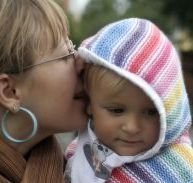 LDS Living Magazine
LDS Living Magazine
Lecia Crider
With approximately half a million U.S. children in the foster care system, the demand for loving foster parents is overwhelming. While foster parenting is fraught with both joys and challenges, many who open their homes to children in need count it among the most rewarding experiences of their lives.
It all started with a pair of cute little grins. Twin girls that lived within Rich and Patti Balluff’s branch boundaries were being sent into foster care, and the branch president asked them if they would consider becoming foster parents and taking the girls in. They readily agreed. By the time they had completed the licensing process, the girls had already been placed in another home, but when the state asked the Balluffs if they would be willing take other children instead, they said yes. That was the beginning, and it’s how I came to grow up in a home with seven of my own siblings, and twenty-three foster brothers and sisters as well.
People who have considered becoming a foster parent often have many questions. What exactly does foster parenting involve? Am I cut out for it? How would it affect my family?
The decision to become a foster parent can become an inner struggle between wanting to help those in need and wondering just how much of yourself you can reasonably give. For some people the decision feels like a gamble. For others, the answer just comes naturally.
Entering the System Entrenched as it is in the bureaucracy of government, navigating the foster care system can leave anyone feeling a little lost. To counteract that confusion, most states have contracted with outside agencies that specialize in offering guidance, training, and support to foster parents.
The Utah Foster Care Foundation (UFCF) is one such agency. For those who are considering becoming foster parents in Utah, contacting UFCF would be the first step. The agency provides an orientation that is designed to give prospective foster parents all the information they need to decide if fostering is right for them. If they choose to move forward with the process, UFCF will walk them through the entire training process, which can be lengthy. While requirements differ by state, Utah mandates 32 hours of training classes as part of the licensing process, and that amount is typical of other states as well. In fact, five-year veteran of foster parenting Stephanie Forsgren, of Mesa, Arizona, said the training and certification process took eight months for her and her husband to complete. The process involved not only many hours of classroom training, but fingerprinting, background checks, applications, and in-home screening interviews as well. It may sound overwhelming, but one major purpose of support agencies like UFCF is to help people get through the whole regimen, step by step.
Support for Families Support for foster parents continues even after the licensing process is complete, and it comes in a variety of forms. From the state, foster parents receive a daily stipend to help offset the cost of caring for the children. The amount is small (perhaps $15-$20 per day), and some states have recently decreased the amount of their stipend, but it does help. Foster children are also provided with health and dental insurance through the state, as well whatever therapeutic services are deemed necessary based on their medical and emotional needs.
Agencies that provide foster care training also provide additional support services as well. Services range widely, from specialized support groups that meet regularly, to programs such as “Wishing Well,” a supplementary financial support that is separate from the stipend provided by the state. Funded by private donors, the Wishing Well might, for example, provide financial assistance to a family whose foster child would like to attend science camp. Almost all foster care agencies provide mentors and respite care for foster parents who need a little break.
All of the support programs available to foster parents are a testimony to one fact that is true across the board: every state, and by extension the agencies they contract with, is anxious to find additional families willing to foster. The need is great. In Arizona, for example, there are almost 10,000 children in the foster care system and only about 3,900 licensed foster families. Since many foster children have special needs and require more attention than they could get in a group home setting, the demand for more foster parents is great.
The special needs many foster children have are another consideration for prospective foster parents. More than a few foster children come from backgrounds of abuse and addiction, and their medical and emotional needs can be far greater than those of a child raised in an environment free of those particular challenges. In fact, as part of the licensing and training process, foster parents are asked to set parameters on who they will accept into their home. For example, foster parents can elect to foster only girls, or only children in a certain age group.
Stephanie Forsgren, a foster mom in Arizona, reminds other foster parents that they must be prepared to accept whatever they have agreed to. She recalls her oldest (now adopted) son coming into her home at five months old, drug exposed and going through withdrawal. Indeed, it would be very hard for her to forget how this little one cried all day and night for months on end. “It was the hardest thing we’ve ever done,” Forsgren remembers, “but he was worth it. It wasn’t his fault.”
The worth of each of these little souls seems to be the common thread linking the sacrifice of foster parents everywhere together. Ask about the rewards of fostering, and you’ll hear answers that are surprisingly similar. “Seeing our foster children laughing, being happy and unafraid,” was Patti Balluff’s greatest reward.
“Seeing those kids thrive and grow and enjoy life and become happy,” said Forsgren.
“The connection I make spiritually with these little ones,” is what keeps Greg Moore, foster dad in Longview, Washington, going.
Aside from the rewards, everyone has a reason to become a foster parent. For my parents, that reason was two cute little faces they couldn’t turn their backs on. The Forsgrens went into foster parenting with the hope of adopting, after a struggle with infertility.
What It Takes First and foremost, preparing your children and yourself for the transient nature of foster care is critical. While some children may stay in your home for months or even years, others will come and go in a matter of weeks or days. The state will return them to their biological family if it is safe and appropriate, or a relative may come forward and offer to care for the child long-term. Whatever the case, saying goodbye is a big part of any foster family’s life.
Jeanmarie Moore of Longview, Washington, has found the goodbyes to be the hardest part of fostering for her biological children, especially when the children leaving are babies. Early in the fostering process she realized she needed to come up with a better way to help her children handle these goodbyes. To that end, she and her husband, Greg, created some “transition” activities they could engage in with their children to make the process a little easier. These activities include regular family councils, where the children receive updates on their former foster siblings and participate in decision making. Writing letters is another helpful transition activity. Their children write letters to the baby that is leaving, and those letters are sent on with the baby. The child may not ever get to read the letters, but the process of writing them helps Jeanmarie’s children find some closure, and that is the real purpose. Foster parents in general will tell you that when a child leaves, it is a true loss, and real grieving follows.
This fact can give any potential foster parent reason to pause. How does anyone contemplating foster care know if they can handle the job, with all its ups and downs? Patti Balluff sums it up best, “Don’t do it unless you love children.” A big heart is perhaps the most important, though unspoken, requirement.
Most foster parents, when asked what it takes to be a foster parent, don’t really focus on the official checklists. Instead, you’ll hear more heartfelt items, like the list compiled by Kris Jacober, a foster parent in Arizona and a Communications Specialist with Arizona’s Children Association, a foster care and adoption support agency. She says the six most important qualities a foster parent should demonstrate are a commitment to helping children, good communication skills, flexibility, good parenting skills, training, and most importantly, a sense of humor.
Of course, even if you have the above qualities, the government still insists that potential foster parents to adhere to specific requirements. You will need to demonstrate that you have the financial, physical, and psychological stamina to care for children, no criminal record, and sufficient space in your home for more people. Usually you can be single or married, although sometimes there is a requirement that there be a stay-at-home parent if you are fostering children under the age of five. Despite the great need for foster parents, the safety of the child comes first, and prospective foster parents are scrutinized in great detail during the certification process. This scrutiny includes home interviews and safety checklists that must be followed exactly, such as keeping chemicals and prescriptions under lock and key.
Balancing Family During her first five years of foster parenting, Stephanie Forsgren has felt blessed to have the time for the attention, consistency, and love that foster children require. In that short span, she and her husband have cared for thirty-seven children. However, now that she has adopted three of those children, each with their own need for love and attention, she and her husband are considering taking a break from the foster care system for a while.
That kind of balancing act between caring for your “forever family” and your foster family can be tricky, and it is one concern that puts off a lot of potential foster parents. But the parents who are already living that balancing act stress the positives. Kris Jacober says, “I would tell any parent who has a desire to foster that it is the best experience her [biological] children could have.”
Having been raised with a couple of dozen foster siblings myself, I know that despite the challenges, crowded rooms, and inevitable jealousies, the main thing I carried away from the whole experience was a desire to serve. Spending my formative years watching my parents give so much of themselves in sometimes difficult circumstances provided me with an example of service that planted itself in my heart and guides many of my decisions today.
If you are considering becoming a foster parent and already have children at home, a good rule of thumb is to foster children who are younger than your youngest child. This will help short-circuit some of the rivalries or unwanted behavior mimicry that can crop up. The following suggestions may also be helpful:
Keep the same set of rules for all children. This may require some extra work on your part. For example, if you would never let your daughter go to school in a mini-skirt, the same should hold true for your foster daughter as well. That might mean going out and getting your foster daughter some appropriate clothing, because she may not have arrived with any.
Give your foster children a space that is their own. Even if it’s just two drawers in a dresser, it may be more than they’ve had before. Being able to feel like something is theirs, not borrowed from someone else, will help your foster children feel more secure and at home.
Don’t be afraid to say no. If a caseworker calls you and has a child to place with a history of behaviors that you know you simply can’t tolerate, it is okay to say no. In fact, it is much healthier for the child for you say no upfront than to take the child in for a week or two, realize you can’t handle it, and send him or her back to get shuffled through the system again.
Fostering Alternatives Is it possible to help foster children without becoming a foster parent? Absolutely! There are many ways to help. Through your state, you can register and train to be one of the caring individuals who provide the occasional day or evening of child care (called respite care) for full-time foster parents.
Arizona’s Children Association actively seeks people to participate in their Life Book program. Life Book volunteers create handmade scrapbook pages that foster and adoptive parents can use to document facts and memories while a child is in their home, providing a valuable sense of belonging for that child. Other ideas include volunteering at one of the family activities that most agencies host, like annual picnic or park days, offering clerical support, or donating money to support foster care programs.
Despite the time commitment of fostering children herself, Jeanmarie Moore has found another fulfilling way to give within the foster care system, and that is by serving as a mentor to mothers whose children have been placed in foster care. Their success can be key to the success of their children. As a mentor, Jeanmarie guides these mothers through a four to six week program designed to teach them the parenting skills they need in order to have their children returned to them. Despite their challenges, Jeanmarie emphasizes that these ladies could be anyone’s daughter. While some are perpetuating a cycle of addiction they learned as children, others may have been raised in a home with all the advantages they could hope for, but somewhere along the line they made a wrong turn. She counts cheering these women on and celebrating their progress, even if it is temporary, as one of her greatest joys.
With all the challenges that foster parenting offers, hearing those who have been through it recount the blessings and joys is heartwarming. The adjustments that have to be made, the extra time required, and the coming and going of different children are all hard, and living with the placement decisions made by the courts can be one of the greatest challenges of foster parenting, but in a way that says something completely wonderful about the whole thing. The fact that these children are so hard to give up means that, in the end, they are immensely lovable. And seeing that look of love in a parent’s eye is what every child really needs.
A Safe Haven for International Children It only takes about three seconds of watching the news to be reminded of the turmoil that is taking place in our world. And the worst part of it is seeing how these wars, natural disasters, and economic downturns affect children around the globe – leaving many of them homeless and parentless.
The U.S. Office of Refugee Resettlement, which helps place international child refugees with foster families, began its program back in the 1980s when thousands of children from Southeast Asia were suffering from the effects of war. They placed 13,000 children in good homes throughout America, with the help of the United Nations.
More recently, this program helped find homes for 3,800 “Lost Boys” who were helpless in Sudan at the beginning of the 21st century, and in 2008, the U.S. (along with 67 other countries) aided 16,300 child refugees through the help of foster parenting programs. Yet, there are still thousands of refugee children in need of good homes today.
If you are looking to help these suffering children find a better life, there are ways to help. For more details, visit adoptinter.org/refugee-youth.htm [Editor’s note: Adopt Int’l no longer has a refugee youth program; the link no longer works] or bethany.org.
© LDS Living, July/August 2010.






